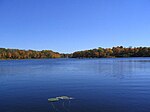Dutch Lake
Dutch Lake is a lake located in the state of Minnesota. It was named for its early German population. It is a 159.50 acres (64.5474 ha) acre lake that is west-southwest of Minneapolis-St. Paul in the Minneapolis suburb of Mound and Minnetrista. It has an average depth of 15.15 feet (4.62 m) and a maximum depth of 45 ft (14 m). Slow Creek, its un-navigable outflow is on its northeast shore. It connects the lake to Lake Minnetonka. It is home to a variety of fish including Black, Yellow, and Brown Bullhead, Black Crappie, Bluegill, Hybrid Sunfish, Largemouth Bass, Northern Pike, Pumpkinseed Sunfish, and Yellow Perch. Much of the Northern shore is owned by Camp Christmas Tree summer day camp.
Excerpt from the Wikipedia article Dutch Lake (License: CC BY-SA 3.0, Authors).Dutch Lake
Willow Lane,
Geographical coordinates (GPS) Address Nearby Places Show on map
Geographical coordinates (GPS)
| Latitude | Longitude |
|---|---|
| N 44.943555555556 ° | E -93.680805555556 ° |
Address
Willow Lane
Willow Lane
55364
Minnesota, United States
Open on Google Maps






